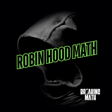Become a Creator today!Start creating today - Share your story with the world!
Start for free
00:00:00
00:00:01

P6: How Many Angles in a Circle? (Curvature; Euclidean Geometry)
Sofía and Gabriel discuss the question of "how many angles are there in a circle", and visit theorems from Euclid, as well as differential calculus.
This episode is distributed under a CC BY-SA 4.0 license. For more information, visit CreativeCommons.org.
Ways to support the show:
Patreon-Become a monthly supporter at patreon.com/breakingmath
The theme for this episode was written by Elliot Smith.
Music in the ad was Tiny Robot Armies by Quiet Music for Tiny Robots.
[Featuring: Sofía Baca, Gabriel Hesch]
Transcript
Introduction and Episode Overview
00:00:07
Speaker
I'm Sophia. And I'm Gabriel. And this is a Breaking Math Problem episode. Before we go into exactly what it is, we're just going to do our plugs really quick. At Patreon, you can support us monthly. It really helps us out. If you pay just one dollar or more, you can have the outlines and you can have the episodes with no ads.
00:00:25
Speaker
And if you pay $22.46, you can get the tensor poster with tensor calculus stuff on it.
Contact and Support Information
00:00:31
Speaker
It has some cool diagrams, everything looks kind of sci-fi, and tensors are used in general relativity. If you just want to buy the poster itself, it's $19.65, which is $15.15 plus $4.50 shipping and handling at facebook.com slash breaking math podcast. Just click on shop. You can also find updates about the show there.
00:00:51
Speaker
We're on Twitter at Breaking Math Pod. Our website is breakingmathpodcast.app. Updates coming soon. If you want to email us, ideas, comments, questions, or corrections, you can email us at breakingmathpodcast.gmail.com.
00:01:03
Speaker
We also have a sister podcast we would like to promote on this show called the touring rabbit holes podcast named after Alan touring. You can find that at youtube.com slash touring rabbit holes podcast. We need to, we need to stop naming things podcasts. That's, that's, you know, a given. The show is starring a guest who's on the breaking math podcast with some frequency named Dr. Alan Alanese and myself actually. And we talk about physics and math as well from his perspective and his history, which is a, it's a cool show.
00:01:30
Speaker
So the thing that started us onto this is, I mean, we've been talking about circles and continuities for like the last few weeks and whatever. But Gabriel, you want to just talk about the Socratic seminars again and like how they led to the question for this episode, which is a kind of nebulous question. How many angles are there in a circle? Do you want to go ahead and explain that?
Socratic Seminars in Math Education
00:01:51
Speaker
Absolutely. So this is actually a pivotal moment in both my understanding of mathematics, but also my teaching philosophy. I had mentioned this in the previous episode. So if you listen to that one, then you're a little bit familiar already. I'm going to go into a little bit more detail now.
00:02:06
Speaker
I'm excited to discuss this question specifically because it came from a very formative time in my life as a math teacher. As you may recall from our previous episode, I was once a math teacher at a small charter school here in Albuquerque, New Mexico called Cottonwood Classical Preparatory School.
00:02:22
Speaker
This school had a requirement as part of its charter that every single subject would participate in something called Socratic seminars. That is, student-led, open-ended discussions in all the classes that are about a philosophical topic or an idea, and it's not graded on correctness so much as it is on participation. Now, we even had them in math and science classes, and I thought that that was quite neat.
00:02:50
Speaker
I find that interesting too, because a lot of times math is presented as the set of rules they have to follow. Like, you know, you have the quadratic formula that you memorize and all this other like, honestly, like debilitating math practice. And I find that very interesting. You're exactly right. Anytime I think of math in any typical classroom, it's exactly what you said. You've got a math textbook with problems and you solve it with the formula the teacher gives you.
00:03:14
Speaker
Which is like paint by numbers to art, which is not an example I thought of. Exactly. So in a math class every couple of weeks or so, we would move all the desks aside and set up all the chairs so they're facing each other.
Do Circles Have Zero or Infinite Angles?
00:03:25
Speaker
And there'll be a discussion just based on a philosophical idea. I thought this was brilliant. And I specifically wanted to mention this experience on this podcast because I'd love it for this practice to be adopted throughout. In fact, if anybody has questions about it, feel free to send them to me at
00:03:43
Speaker
BreakingMathPodcast at gmail.com, and I'll tell you a bit more about this practice of Socratic seminars. Now, during one Socratic seminar in this math class, we were discussing infinity. I don't quite recall what the specific question was that started the conversation, but at one point the question was asked,
00:04:03
Speaker
Do circles have zero angles? Or do they have an infinite amount of angles? These students were allowed to think about it and then discuss it following some basic rules of discussion. I found this question fascinating. And again, I don't even remember where it came from. It was brought up in the natural flow of this conversation. Now, I do want to specify that by angles, we can also call it points as well. Of course, a point would be where two lines intersect at any degree.
00:04:33
Speaker
Well, yeah, and I think like specifically, definitely what you mean is like because an angle, an angle is between three points or like kind of like the intersection between two lines, right? Correct. And a point is just where they intersect. So you could see every point on the circle as having an angle because there's a line going into and out of that.
00:04:50
Speaker
Now, what was cool is, again, this conversation was with middle school students and we're not grading for mathematical rigor or even necessarily correctness. We're just grading on participation. The discussion followed like so. You can start off with a single point and then you can add another point with which you can make a line between the two points. You can add a
00:05:14
Speaker
third point and you would get a triangle, a fourth point would create a square, and you can keep adding points in this general shape. And again, I realize we discussed this on previous episodes, but it's worth bringing up again.
Infinite Circle as a Straight Line
00:05:27
Speaker
You can add eight points and create an octagon. Essentially, you can add n points and create an n-sided
00:05:36
Speaker
shape that essentially approaches a circle. So the argument could be made that a circle has infinite angles, infinite points. Yeah. And of course, like every point can be said to have an angle. And we also had the discussion last time on the episode, we're going to go into more detail. And you said you had in the Socratic seminar as well, the idea of an infinitely large circle being a straight line.
00:06:02
Speaker
Yes, so again, as long as students are talking about infinity and ways to, I don't want to say measure it, but grasp it at least conversationally, the students had said, so as you start with a circle, and if you increase the radii,
00:06:20
Speaker
it appears to come apart, so to speak. Well, if you stand on the earth, it may appear flat. We know that it's curved, but it certainly appears flat. So from a given vantage point, if you increase the size of a circle,
00:06:36
Speaker
in the process of increasing the size, it appears to, perhaps it could appear to get flat. The question was asked, if you increase a circle so that the radius is an infinite length, do you have a flat line or not? Discuss. And again, in the spirit of a Socratic seminar, we're not necessarily concerned, at least right away, with rigorous mathematical definitions, but more or less the process of how you get there.
00:07:03
Speaker
I thought that was a brilliant, brilliant question. It took me a very long time to arrive at what I believe is the right answer. But again, I say this more as an approach for learning and a hope that some other teachers might adopt Socratic seminars even in math classes.
00:07:20
Speaker
Yeah, I mean it's definitely a good thing to encourage this kind of open-ended discussion and it also keeps a teacher on their toes and as a teacher should be. If a teacher of yours, a professor of yours, anyone like that, if they can't deal with you asking questions or you pointing out things that you think are wrong, then they are not good at their job. Just as simple as that.
00:07:42
Speaker
And many, and most of the people in the audience, most of their teachers are probably bad teachers in my experience. And it's because of this fear. So in that spirit, but also in that spirit and also the spirit of breaking math problem, episode rigor, we're going to go into these questions.
00:07:58
Speaker
Now, without further ado, we will attempt to answer both of these questions with a bit more rigor than what happened during the Socratic Seminar. So we talked about in the last episode that there's this cardinality, meaning like this amount, called LF1. And it's the amount of real numbers that there are, right? 1.3 pi, anything that you could think of that's a number.
00:08:19
Speaker
The number of the cardinality of those is alif 1 correct and alif 1 is uncountable, right? Meaning that like alif 0 is like all the natural numbers or all the squares go back to last episode if you want more information on that But you cannot count you cannot put all the points in a plane or a line or a cube in order You will leave some out every dime. Yes
00:08:40
Speaker
In fact, you'll leave out literally 99.9999, infinite number of nines, percent of them, basically only one over infinity of the points is what you'll get if you have a countable number of points.
Angles on a Circle and Straight Lines
00:08:51
Speaker
Yes. And again, what you're saying is, so if you, you know, if you draw a straight line, there are an uncountable amount of points in that line. And you can also take that straight line and bend it into a perfect circle mathematically. And the same thing would apply because a perfect circle can be made simply by a straight line.
00:09:08
Speaker
Yeah, and because the line segment also has the same number of points as the whole real line, right? Yes. So that should be in and of itself sufficient to mathematically prove that a circle has an uncountable amount of points. Yeah, because for every point in a circle, there's a point on some line, and we could stretch that line out from negative infinity to infinity in a rigorous way using an inverse sigmoid function and like, you know, like arc tangent or various means. Yes. And yeah.
00:09:36
Speaker
We will now discuss a little bit about the differences and similarities between an angle and a point on the circumference of a circle. So obviously the points on the circumference of the circle are just the points that make up that circumference, right? Correct. And there's Aleph one of those. Yes.
00:09:53
Speaker
But so you could say that each point on the circle, right, if you zoom in far enough, it's going to have some angle, right? Because let's go back to the triangle square thing, right? Yes. The triangle has angles of 60 degrees if they're all equal, right? Yes, an equilateral triangle, correct. Yeah, and if it's a four-sided figure, then everything has 90 degrees. Assuming that, well, yeah, unless you've got a rhombus, but...
00:10:17
Speaker
Oh yeah, but I'm just saying like of equidistant points so that like all points are equidistant from each other and all equidistant from some center point and that's how we could define things that approach a circle without using the concept of a circle. Yes. And if you keep moving, you notice that these numbers will get bigger and bigger, but there's a point, there is something that they are approaching.
00:10:38
Speaker
And that is 180 degrees, which is just a straight line, two right angles. Correct. And so you might think like, oh, how can this be? How can we go all the way to infinity? And the thing is, all we have to do is use the definition of a circle, which is continuous itself, right? Yes. And this was actually proven by Euclid like 2500 years ago or whatever.
00:10:59
Speaker
So let's imagine that you have a circle, right? Imagine a circle in front of you and there's a line resting on top of the circle, right? Yes. So it looks like, it looks like, it looks like a wheel rolling on like a drawing of a road or something like that. Sure. Absolutely. Just so any circle that is, that is, that comes into contact with a straight line.
00:11:19
Speaker
Yeah, at exactly one point. There's no cords within the line, anything like that. Okay, so a perfectly straight line touching a perfectly round circle and it doesn't go through it, it touches it at one point.
00:11:30
Speaker
Yeah, and touching it at one point means it's tangent to that line. Correct. Now let's say we draw a line from the center of the circle to the point that the line meets the circle, right? That one point that it touches. Yes. That will be the radius of the circle, right? Correct. And that's just by the definition of a radius. A circle is a point and a radius. Yes. And the radius touches the edge from the center. So what is the angle between the radius and the tangent line?
00:11:54
Speaker
So just those two, it's two 90 degree angles or a single 180 degree angle. Yeah, and 180 degrees total with 90 degrees on each side, right? Correct. So it meets it at a perfect L. Perfect perpendicular. Yeah, this is like high school, even elementary geometry.
00:12:16
Speaker
What's interesting, though, is that it's something that needs to be proven with a Euclid system. There's not enough. It's something that we actually have to prove rigorously. And we're going to do that now. But instead of imagining this abstract circle, because we're going to get a little bit complicated, we're going to make it a little bit simpler by making it physical for you. So imagine you have a plate, right? Yes. On a table. It's a round plate.
Paradox of Infinite Circles and Straight Lines
00:12:39
Speaker
And you get a ruler and you touch it to the edge of the plate. So just like, so that, so the line on the edge of the ruler is tangent to the circle that's on the edge of the plate. Right. So let's, so let's suppose though that, so if I draw a line from like the center of the circle to the ruler and then draw the line along the ruler, it's going to be a 90 degree angle. That's what we claim, right? Correct. So we're going to do a proof by contradiction and we're going to assume the opposite. Okay.
00:13:03
Speaker
We're going to assume that it is not a 90 degree angle. So we're going to assume that there's some point. Let's just say that it's to the right on the ruler. So like you just go down the ruler a little bit outside of where it's touching the plate. And at this point, let's say let's suppose that that is the 90 degree angle. Yes.
00:13:23
Speaker
And if it were on the left, you just have to flip the scene around, do it in a mirror. So that means that if we made a triangle going from the center of the plate to the point that we're claiming it's a right angle, right? On the ruler? Yes. Let's just say we marked that with a red dot. So to the red dot and to the point where the plate meets the circle and back, it would have a 90 degree... We're saying that it would have a 90 degree angle at that dot, right? On the ruler. Okay. So how many degrees are there in a triangle? In the interior angles? 180.
00:13:52
Speaker
Yeah, and since we already used up 90 of those, the two angles that remain, which is again the angle at the center of the circle, right? And the angle where the ruler touches the radius, we're saying that both of those must be less than 90 degrees, right? Correct. Because you have to split 90 degrees between two things.
00:14:12
Speaker
So in triangles, like one fact about triangles that we don't want to prove here, you could find plenty of wonderful proofs online, is that in a triangle, the angle that is the largest, the opposite side is also is the longest of the sides. So does that make sense? Yes, it does. Absolutely.
00:14:29
Speaker
And so since it's the greatest angle, the opposite side is the line on our triangle that goes from the center of the circle, of the plate to the ruler, right? And we're saying that that distance must be longer than the distance from the center of the circle to the point on a ruler outside of the circle. But since the distance to that point, the point that red point is longer than the radius because it contains the radius, right?
00:14:55
Speaker
It must be longer than the other piece. So we have a contradiction there. I see. And that must mean that we've proven out what we set to prove. Yeah, exactly. And so it's kind of weird though, right? Because what we've proven here is that at every point in the circle, it seems to be a flat line. It seems to not be different than a flat line. Correct. Which seems a little bit weird. One might have the question, where did the angle go? How do we measure that?
00:15:19
Speaker
However, essentially what we're saying is that for the purpose of a circle, every point on the circle is an angle. And you can say it's an angle because you can imagine first that you draw two points next to the circle, right? And then you draw the angle and then you get the points closer and closer. So there really is this infinitesimal calculus aspect to a lot of Euclid's proofs, especially the ones dealing with circles where they kind of bypass that with the cleverer stuff.
00:15:42
Speaker
Yes. So what we're showing then is that this proof shows that earlier we accepted that a circle has an infinite amount of points, again, through this more formal rigorous proof. A circle also has an infinite amount of angles. And all those angles are straight line. Yes. Which is weird. It is weird. So why is a circle not a straight line?
00:16:05
Speaker
So now, so I love your transition. So since every angle on a circle is like a straight line, why is a circle not a straight line? This is the other part of the question from the Socratic Seminar that was brought up, or rather it's similar to it, and I think it's a wonderful lead in to that second question. That question was, if you have a circle from a given point, from a given vantage point, and if you continuously increase the circle,
00:16:34
Speaker
all the way to infinity, granted that's not actually possible, but if you were to increase the radius of a circle to infinity, would the circle be a straight line?
00:16:45
Speaker
And we can examine that a little bit by looking at the idea of infinitesimal change as you go along paths. So let's imagine real quick that you're on a roller coaster, right? Yes. If you've been on a roller coaster or even in a car, you notice that when you take curves and stuff, you feel centrifugal force, right? Correct. Believe it or not, the centrifugal force is related to a concept called curvature, which allows us to discuss what we're talking about. Yes.
00:17:10
Speaker
So let's do a quick review on velocity and acceleration. Gabriel, what does it mean to say that velocity is the time derivative of position? So a derivative is a measure of change, essentially. So if velocity is the time derivative of position, it is the change in position over time, and it happens in infinitesimal increments.
00:17:31
Speaker
Yeah, and I think it's kind of cool because if you keep going with this, and we've talked about this many times, but it bears repeating because it's a new episode, the acceleration is a time derivative of the velocity. Correct. And that means it's measured in like units of distance per time per time. So like an acceleration of one meter per second per second would mean that after one second is going to one meter per second. After two seconds is going two meters per second and so on.
00:17:59
Speaker
So now that we got that out of the way, let's talk about arc length parametrization.
Curvature and Paths in Mathematics
00:18:04
Speaker
So parametrization is you put in a variable like time, right? And you go along a path and it squiggles out a path. You have like some vector or some point generated at every point. So for a circle, it might take two pi of our units, depending on how we write it, and it would go along in a circle generating an X and a Y coordinate at every point for time, right?
00:18:27
Speaker
But the arc length parameterization is assuming that we draw a curve in midair. Imagine a roller coaster where you're going the same speed the entire time, which that would be the arc length parameterization of a curve. And we could use that to talk about curvature. So yeah, so arc length parameterization, let's just say we call that gamma of s, s being the distance.
00:18:51
Speaker
So if we follow the curve from gamma zero to gamma s, we'll have traveled how many units along that curve? S units along that curve. So now if we take the derivative over s, it's kind of like taking the derivative over time of a particle moving at a constant speed along that path, right?
00:19:06
Speaker
So that is like the velocity. And it's the first derivative of the arc length parameterization position. So if we call that gamma, the tangent vector, which is also the velocity, will be called T of S, which is gamma prime of S, prime meaning derivative. And it's something you need to do with context. Yeah, so now the derivative of the velocity is acceleration, right? Yes.
00:19:31
Speaker
If we take the second derivative of our arc length parametrization, that is the acceleration that we would feel along that point. So basically, there would be like, if we were in space going along this path, how our stomachs would turn, basically, where gravity would feel like it's going. And the curvature is the magnitude of that acceleration. Because remember, acceleration, let's say we're doing a circle, right? The acceleration will be pointing towards the center. It's the same reason why the moon orbits the Earth. The Earth is pulling on the moon and the moon is moving sideways.
00:20:00
Speaker
So the magnitude of the acceleration of an arc length parameterization is the curvature. And what's cool about the curvature is it's inversely proportional to the radius. If you're drawing a circle, then it's like that, right? It's inversely proportional to the radius. So if our radius is three, our curvature is one-third. If our radius is infinity, our curvature is what? Zero.
00:20:23
Speaker
So in that way, we could imagine a straight line being a circle and then, because one of my problems sometimes with defining a straight line is a circle, depending on what system, is in euclidean geometry, it doesn't seem to make much sense, right? Correct. Because the radius would have to be infinity plus like three feet away, which doesn't make much sense. Yes. But with this thing, with the parameterization, you can basically freeze the velocity in time and the circle in this system is a straight line if it's infinite.
00:20:48
Speaker
This is so interesting. So when we're talking about infinitesimals, like in this problem, a circle isn't necessarily a straight line at a certain point. Yeah, it's the system that we work in, because we really have to be careful with that as mathematicians.
00:21:08
Speaker
I mean a famous example is Naive's set theory was used in the late 1800s. And then somebody said, I can't remember who it was. What if you had the set of all sets that don't contain themselves, right? Yes. Would that set contain itself?
00:21:22
Speaker
Oh, wow. There you go. The answer is both yes and no. So that means that that naive set theory is that so like, so if you're working in Euclidean geometry of a straight line cannot be a circle. If you're working on the surface of a sphere, every straight line is a circle. Yes. Wow. Goodness. That's a, that's a head spinner. Yeah. Right. Yes. Yes.
00:21:41
Speaker
And this actually applies for every continuous function. So anything that doesn't jump or like change... So like if I change directions infinitely abruptly, first of all, I would probably disintegrate because my acceleration would be infinite and I would turn into a cloud of light. But if I approach that, that would be like a curvature of infinity at that point.
00:22:03
Speaker
And that's really the only place the angles exist on a path is where the curvature changes abruptly. Those are the only angles that are not 180 degrees. So I just think that's kind of fascinating that just infinitesimal calculus has given us a way to talk about the tangent of pretty much anything. Thank you, Newton and Leibniz. Yes, that's fascinating. Now, earlier you were saying, before we got into the physics element, you were saying that the curvature is inversely proportional to the radius.
00:22:33
Speaker
Yeah, and we can actually show that with the physics. So the centrifugal force that we feel when we're going around a circle is equal to the square of the angular velocity, which is basically radians of, a radian is the angle that one radius subtends, is radians over time, right? Yes. So the acceleration that you feel going around a circle is omega, which is angular velocity squared times R. Yes.
00:23:01
Speaker
Let's imagine that we are traveling at speed one around a circle, right? Yes. And can you explain what speed one means? Sure, sure. Again, velocity is the derivative of position. So it's the change in position over time.
00:23:19
Speaker
Yeah, so if we're going at speed one, it means we're going one unit of distance per one unit of time, or like 10 units of distance per 10 units of time. They're equal, right? Yes. So let's say we have a circle of radius of R, right? R distance units. Okay. What will the circumference of that circle be? If it's R, the circumference would be two pi R. All right, so since we're going two pi radians, right, which is a full circle in a full circle,
00:23:45
Speaker
in 2 pi r time. That means that we're going 1 over r radians per second, which means that omega is 1 over r. And so acceleration we already said is omega squared r, right? Yes. So omega is 1 over r. So what's 1 over r squared times r? 1 over r.
00:24:02
Speaker
Yep, and since that means acceleration is equal to 1 over R. And so since acceleration is kind of what our curvature is, or at least the magnitude of acceleration is what our curvature is, that means that curvature is inversely proportional to R using this physical argument.
00:24:19
Speaker
So when we explore creating a circle through acceleration, or rather moving at a constant speed in a circle, that is a form of acceleration. And we have shown that all continuous functions have an angle, quote unquote, of 180 degrees. And an angle is a way of measuring an abrupt change or relation.
Polygons and Pi Approximation
00:24:42
Speaker
The reason why is because the tangent can be calculated using calculus.
00:24:49
Speaker
Now, with respect to circles and polygons, we said earlier we talked about creating a shape that approximates a circle by continuing to add angles that are the same distance apart. Yeah, which is also just quick. Archimedes of Syracuse used that to calculate his values for pi.
00:25:07
Speaker
Yes, where he made both on the inside of a circle and on the outside of a circle. He made the outside of a circle, he kept adding angles, same as the inside. So they got closer and closer to approximating each other's shape. And then he took the average of those two. Yes. And he got really close, like he got like three digits, I believe. Yes, exactly. So he kept adding angles to a polygon and they ended up at a circle.
00:25:30
Speaker
And the proof in Euclid that also uses this, by the way, that if you keep adding angles to the circle, I think it's a proof on... There's a few proofs that use that, like the proof that the volume of cylinder is equal to the area of the circle times the height uses this because you have like basically a triangular prism and you keep adding segments to it and you inscribe and circumscribe it. And the thing that you do with that is that when it goes to infinity, you show that it can't be more or less
Philosophical Implications of Infinite Radius Circles
00:25:54
Speaker
than something.
00:25:54
Speaker
So yeah, so through discussing derivatives and acceleration and physics, we have a roundabout way of discussing whether a circle with an infinite radius is in fact a straight line. And how, you know, this is a different way of answering that question. So the answer would be it's made of infinite straight lines.
00:26:17
Speaker
Either it's made of infinite straight lines or it cannot be defined as in, you know, traditionally Euclidean stuff, or it is a line because it's parameterized as an infinite circle. Like you can imagine it like, you know that when you get those audio bugs where you just go like,
00:26:33
Speaker
Yes, yes, and it's kind of like that basically yes You know like when you hold you I'm not sure if you did this as a kid But like if you ever have one of those fans that goes back and forth if you hold it in place That clicks and squeaks and probably it's not good for the fan. Yes, it's we're doing that for this article
00:26:49
Speaker
Pretty much, yes. And the
Enhancing Education with Socratic Seminars
00:26:51
Speaker
other thing is, without getting into the rigorous mathematics, but just talking about definitions, I prefer to say that it's a meaningless idea to discuss a circle with a radius of infinity. I prefer to, I don't want to say, you know, as my cop-out, as it were, but I prefer to say that question in of itself is meaningless.
00:27:13
Speaker
And I think that my philosophical view on it is slightly similar and slightly different. My view is that it makes sense only to talk about the side of the circle that you can see if it's a straight line. The other side of the circle is meaningless to talk about. Yeah, yeah, absolutely. So again, when we talk about infinitesimals, as soon as you bring infinity to the party, things get weird.
00:27:36
Speaker
Oh, yeah. And honestly, like the outline of like Daffy Duck could be considered a straight line if you made it big enough. Yes, yes. Yeah, exactly. So it is weird. So I was thrilled to do this problems episode because we both get into some rigorous mathematics. But we also, you know, and I honestly think more importantly, arguably, I introduced the idea of doing a secret and open ended Socratic seminar discussion with kids in middle school and see where the conversation goes.
00:28:06
Speaker
Yeah, ideas are born of discussion. And if you teach your students how to respond to new information or contradictory information by processing it in front of them, you can do them a great service. It's critical thinking. It's all this good stuff. So yeah, Gabriel's suggestion is amazing. Thank you. And it wasn't my idea, but I got to witness it. Gabriel came up with this idea. Socrates was a myth.
00:28:28
Speaker
Oh gosh,
Episode Conclusion and Listener Reminders
00:28:29
Speaker
gosh. All right, until next time. I'm Sophia. And I'm Gabriel. And this has been a breaking math problem episode. Email us at breakingmathpodcast at gmail.com and contribute to our Patreon at patreon.com slash breakingmath.



















